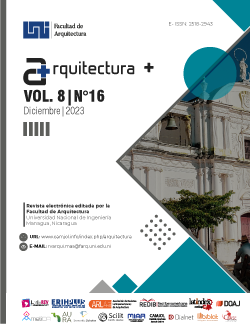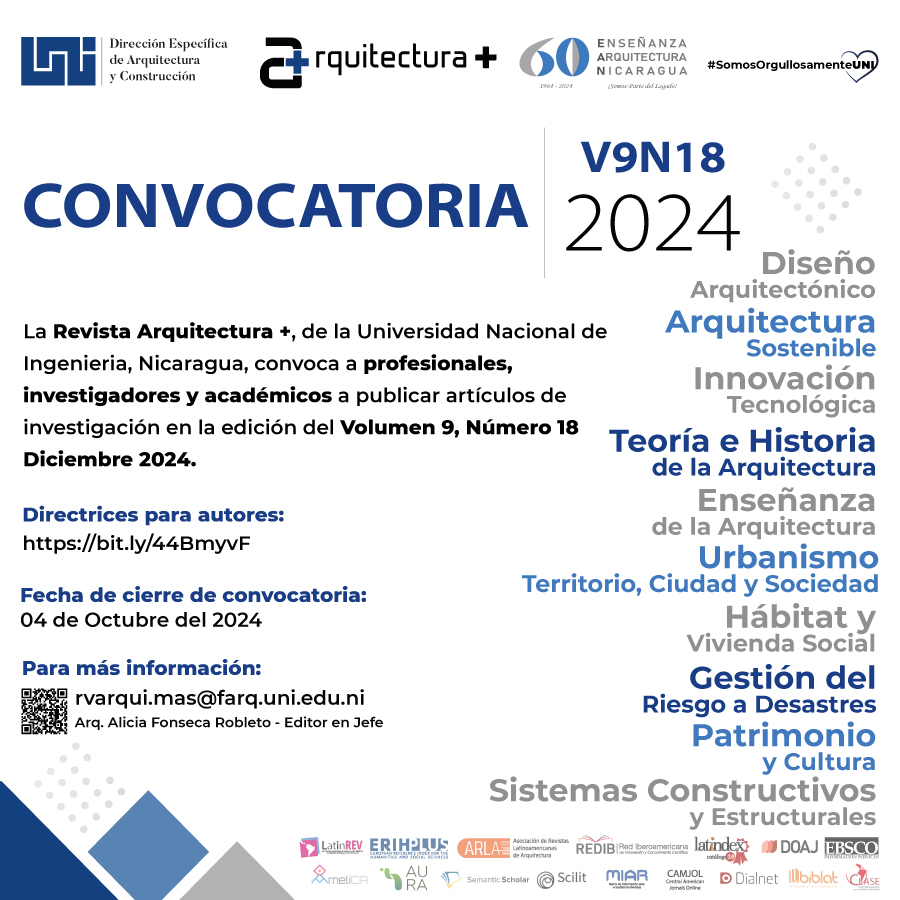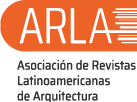Exploración de las relaciones entre morfología urbano-edilicia y vegetación en ciudades ubicadas en zonas áridas. Caso Ciudad de Mendoza, Argentina
DOI:
https://doi.org/10.5377/arquitectura.v8i16.17423Palabras clave:
Análisis-estadístico, hábitat, morfología-urbano-edilicia, renaturalizar, vegetaciónResumen
El crecimiento exponencial de la población mundial y la expansión urbana han afectado la vegetación en las ciudades, especialmente en regiones áridas. El objetivo del trabajo es comprender la relación entre la morfología urbano-edilicia y la vegetación en 36 manzanas, ubicadas a lo largo del zanjón Frías en la Ciudad de Mendoza, Argentina. Metodológicamente se emplearon sistemas de información geográfica y se realizó un análisis estadístico de datos para estudiar las correlaciones entre las variables urbano-edilicias, el índice de vegetación de diferencia normalizada (NDVI) y las variables del arbolado urbano para los casos de estudio. Posteriormente, se identificaron y analizaron las manzanas con valores extremos en el índice de vegetación. Los resultados obtenidos señalan un impacto negativo de la huella edilicia sobre el índice de vegetación, siendo la variable más fuertemente correlaciona. El análisis de manzanas con valores extremos en los índices de vegetación identificó oportunidades para la incorporación de vegetación autóctona y la promoción de una identidad más naturalizada. Como conclusión las manzanas analizadas poseen potencialidades para su renaturalización y ofrecen una oportunidad, basada en la morfología urbano-edilicia, en el arbolado y en la proximidad a la infraestructura aluvional, para la regeneración de un corredor ecológico. Finalmente, en un contexto de escasez hídrica y vulnerabilidad al cambio climático, surge el desafío de renaturalizar espacios urbanos insertos en un modelo de "ciudad oasis" a fin de mejorar la calidad de vida y la resiliencia urbana.
Descargas
Citas
Arboit, M., Diblasi, A., Llano, J. F., y de Rosa, C. (2008). Assessing the solar potential of low-density urban environments in Andean cities with desert climates: The case of the city of Mendoza, in Argentina. Renewable Energy, 33(8), 1733-1748. https://doi.org/10.1016/j.renene.2007.11.007
Arboit, M., y Maglione, D. (2018). Situación actual y cambios recientes en los índices de vegetación (vis) en ciudades forestadas con climas secos. Caso área metropolitana de Mendoza, Argentina. Urbano, 21 (38), 18–35. https://doi.org/10.22320/07183607.2018.21.38.02
Arboit, M., y Maglione, D. (2019). Impacto edilicio y del arbolado sobre el índice de vegetación en el área metropolitana de Mendoza, Argentina. Proyección. Recuperado de: https://revistas.uncu.edu.ar/ojs3/index.php/proyeccion/article/view/2836
Arboit, M., y Maglione, D. (2022). Análisis de componentes principales de la morfología urbano edilicia del Área Metropolitana de Mendoza, Argentina. Urbano, 25(46), 106-121. https://doi.org/10.22320/07183607.2022.25.46.09
ArcGIS. Esri [en línea] (2023). Environmental Systems Research Institute, Inc. Disponible en: www.esri.com
Artmann, M., Inostroza, L. y Fan, P. (2019). Urban sprawl, compact urban development and green cities. How much do we know, how much do we agree?. Ecological indicators, 96, 3. https://doi.org/10.1016/j.ecolind.2018.10.059
Barbosa, O., Tratalos, J. A., Armsworth, P. R., Davies, R. G., Fuller, R. A., Johnson, P. y Gaston, K. J. (2007). Who benefits from access to green space? A case study from Sheffield, UK. Landscape and Urban planning, 83(2-3), 187-195. https://doi.org/10.1016/j.landurbplan.2007.04.004
Bar-Massada, A., Radeloff, V. C., y Stewart, S. I. (2014). Biotic and abiotic effects of human settlements in the wildland–urban interface. Bioscience, 64(5), 429-437. https://doi.org/10.1093/biosci/biu039
Benedetti, Y., Callaghan, C. T., Ulbrichová, I., Galanaki, A., Kominos, T., Abou Zeid, F., ... y Morelli, F. (2023). EVI and NDVI as proxies for multifaceted avian diversity in urban areas. Ecological Applications, 33 (3), e2808. https://doi.org/10.1002/eap.2808
Bórmida, E. (2014). Mendoza, una ciudad oasis. Revista de la Universidad de Mendoza, (4/5), 131-137. Recuperado de: https://www.um.edu.ar/ojs2019/ index.php/RUM/article/view/189
Cantón, M. A., Mesa, A., Cortegoso, J. L., y de Rosa, C. (2003). Assessing the solar resource in forested urban environments: results from the use of a photographic-computational method. Architectural Science Review, 46(2), 115-123. https://doi.org/10.1080/00038628.2003.969697
Capeluto, I. G., Yezioro, A., Bleiberg, T., y Shaviv, E. (2006, September). Solar rights in the design of urban spaces. In Comunicación presentada en la 23rd Conference on Passive and Low Energy Architecture. (Vol. 23).
Coleman, A. F., Eisenman, T. S., Locke, D. H., y Harper, R. W. (2023). Exploring links between resident satisfaction and participation in an urban tree planting initiative. Cities, 134, 104195. https://doi.org/10.1016/j.cities.2023.104195
Dangulla, M., Abd Manaf, L., y Ramli, M. F. (2023). Determining the response of vegetation to urbanization and land use/land cover changes using NDVI and NDBI differencing techniques. Research Square. Prepint (Version 1). https://doi.org/10.21203/rs.3.rs-3050037/v1
Davis, A. Y., Jung, J., Pijanowski, B. C., y Minor, E. S. (2016). Combined vegetation volume and “greenness” affect urban air temperature. Applied Geography, 71, 106-114. https://doi.org/10.1016/j.apgeog.2016.04.010
Demuzere, M., Hankey, S., Mills, G., Zhang, W., Lu, T., y Bechtel, B. (2020). Combining expert and crowd-sourced training data to map urban form and functions for the continental US. Scientific Data, 7, 264. https://doi.org/10.1038/s41597-020-00605-z
Dirección General de Catastro [en línea] (2023). Disponible en: https://www.atm.mendoza.gov.ar/portalatm/zoneTop/catastro/catastro.jsp
Di Rienzo J.A., Casanoves F., Balzarini M.G., Gonzalez L., Tablada M., Robledo C.W. InfoStat versión 2020. Centro de Transferencia InfoStat, FCA, Universidad Nacional de Córdoba, Argentina. Recuperado de: http://www.infostat.com.ar
Domingo, D., Van Vliet, J., y Hersperger, A. M. (2023). Long-term changes in 3D urban form in four Spanish cities. Landscape and Urban Planning, 230, 104624. https://doi.org/10.1016/j.landurbplan.2022.104624
Duncan, J. M., y Boruff, B. (2023). Monitoring spatial patterns of urban vegetation: A comparison of contemporary high-resolution datasets. Landscape and Urban Planning, 233, 104671. https://doi.org/10.1016/j.landurbplan.2022.104671
Fan, C., Myint, S. W., Kaplan, S., Middel, A., Zheng, B., Rahman, A., ... y Blumberg, D. G. (2017). Understanding the impact of urbanization on surface urban heat islands—A longitudinal analysis of the oasis effect in subtropical desert cities. Remote Sensing, 9(7), 672. https://doi.org/10.3390/rs9070672
Ferreira, L. S., y Duarte, D. H. S. (2019). Exploring the relationship between urban form, land surface temperature and vegetation indices in a subtropical megacity. Urban Climate, 27, 105-123. https://doi.org/10.1016/j.uclim.2018.11.002
Gandhi, G. M., Parthiban, B. S., Thummalu, N., y Christy, A. (2015). Ndvi: Vegetation change detection using remote sensing and gis–A case study of Vellore District. Procedia computer science, 57, 1199-1210. https://doi.org/10.1016/j.procs.2015.07.415
Givoni, B. (1998). Climate considerations in building and urban design. John Wiley & Sons.
Grabowski, Z. J., McPhearson, T., y Pickett, S. T. (2023). Transforming US urban green infrastructure planning to address equity. Landscape and Urban Planning, 229, 104591. https://doi.org/10.1016/j.landurbplan.2022.104591
Heynen, N. C., y Lindsey, G. (2003). Correlates of urban forest canopy cover: implications for local public works. Public Works Management & Policy, 8(1), 33-47. https://doi.org/10.1177/1087724X03008001004
Hua, J., Cai, M., Shi, Y., Ren, C., Xie, J., Chung, L. C. H., ... y Webster, C. (2022). Investigating pedestrian-level greenery in urban forms in a high-density city for urban planning. Sustainable Cities and Society, 80, 103755. https://doi.org/10.1016/j.scs.2022.103755
Huang, J., Lu, X. X., y Sellers, J. M. (2007). A global comparative analysis of urban form: Applying spatial metrics and remote sensing. Landscape and urban planning, 82(4), 184-197. https://doi.org/10.1016/j.landurbplan.2007.02.010
Huete, A. R., Jackson, R. D., y Post, D. F. (1985). Spectral response of a plant canopy with different soil backgrounds. Remote sensing of environment, 17(1), 37-53. https://doi.org/10.1016/0034-4257(85)90111-7
Huete, A., Didan, K., Miura, T., Rodriguez, E. P., Gao, X., y Ferreira, L. G. (2002). Overview of the radiometric and biophysical performance of the MODIS vegetation indices. Remote sensing of environment, 83(1-2), 195-213. https://doi.org/10.1016/S0034-4257(02)00096-2
Infraestructura Datos Espaciales Mendoza IDE [en línea] (2023). Disponible en: https://www.mendoza.gov.ar/idem/
Instituto Geográfico Nacional IGN [en línea] (2023). Disponible en: https://www.ign.gob.ar/NuestrasActividades/InformacionGeoespacial/CapasSIG
Kaushik, M., Tiwari, S., y Manisha, K. (2022). Habitat patch size and tree species richness shape the bird community in urban green spaces of rapidly urbanizing Himalayan foothill region of India. Urban Ecosystems, 25(2), 423-436. https://doi.org/10.1007/s11252-021-01165-9
Li, R., Liu, Z., Feng, L. y Gao, N. (2022). Simulación dinámica de fluidos rápidos de las distribuciones de flujo de aire en áreas residenciales urbanas. Energía y Edificios, 255, 111635. https://doi.org/10.1016/j.enbuild.2021.111635
Li, X., Jia, B., Li, T. y Feng, F. (2023). Studying the spatial evolutionary behavior of urban forest patches from the perspective of pattern-process relationships. Urban Forestry y Urban Greening, 81, 127861 https://doi.org/10.1016/j.ufug.2023.127861
Li, Z., Zhao, Y., y Hu, D. (2023). Evaluating the impacts of three-dimensional building morphology on urban near-surface energy fluxes: A case study in Beijing, China. Energy and Buildings, 279, 112690. https://doi.org/10.1016/j.enbuild.2022.112690
Litteral, J. y Wu, J. (2012). Urban landscape matrix affects avian diversity in remnant vegetation fragments: evidence from the Phoenix metropolitan region, USA. Urban Ecosystems, 15, 939-959. https://doi.org/10.1007/s11252-012-0245-4
Molina, G., Arboit, M., Maglione, D., Sedevich, A. y Mutani, G. (2020). Estudio de expansión urbana, crecimiento poblacional, consumos energéticos e índices de vegetación en el Área Metropolitana de Mendoza. ÁREA, 26(1), 1-21. Recuperado de https://area.fadu.uba.ar/area-2601/molina-et-al/
Municipalidad de la Ciudad de Mendoza [en línea] (2023). https://ciudaddemendoza.gob.ar/secretaria-planificacion-infraestructura-y-ambiente/obras-privadas/mapas/
Naciones Unidas. (2023). Recuperado de: https://www.un.org/es/desa-es/la-poblaci%C3%B3n-mundial-llegar%C3%A1-8000-millones-en-2022#:~:text=Las%20%C3%BAltimas%20proyecciones%20de%20las,y%209700%20millones%20en%202050.
Nature in the Urban Century. (2018). The Nature Conservancy Robert I. McDonald, M’Lisa Colbert, Maike Hamann, Rohan Simkin, Brenna Walsh.
Nowak, D. J., Hoehn, R. E., Bodine, A. R., Greenfield, E. J., y O’Neil-Dunne, J. (2016). Urban forest structure, ecosystem services and change in Syracuse, NY. Urban Ecosystems, 19, 1455-1477. https://doi.org/10.1007/s11252-013-0326-z
Oke, T. R. (1973). City size and the urban heat island. Atmospheric Environment (1967), 7(8), 769-779. https://doi.org/10.1016/0004-6981(73)90140-6
Ossola, A., Locke, D., Lin, B., y Minor, E. (2019). Yards increase forest connectivity in urban landscapes. Landscape Ecology, 34, 2935-2948. https://doi.org/10.1007/s10980-019-00923-7
Owens, S. (1986). Energy planning and urban form. London: Pion Ltd.
Parton, L. C. (2023). Measuring the effects of public land use change: An analysis of greenways in Raleigh, North Carolina. Land Use Policy, 131, 106689. https://doi.org/10.1016/j.landusepol.2023.106689
Persson, M., Lindberg, E. y Reese, H. (2018). Tree species classification with multi-temporal Sentinel-2 data. Remote Sensing, 10(11), 1794. https://doi.org/10.3390/rs10111794
QGIS.org [en línea] (2023). Sistema de Información Geográfica QGIS. Asociación QGIS. Disponible en: http://www.qgis.org
Rahman, M. A., Stratopoulos, L. M., Moser-Reischl, A., Zölch, T., Häberle, K. H., Rötzer, T., ... y Pauleit, S. (2020). Traits of trees for cooling urban heat islands: A meta-analysis. Building and Environment, 170, 106606. https://doi.org/10.1016/j.buildenv.2019.106606
Rajbhandari, A., Matteson, K., Katz, E., LeBuhn, G., y Johnson, E. (2023). Bee visitation to flowers throughout New York City. Landscape and Urban Planning, 233, 104689. https://doi.org/10.1016/j.landurbplan.2023.104689
Rouse Jr, J. W., Haas, R. H., Deering, D. W., Schell, J. A., y Harlan, J. C. (1974). Monitoring the vernal advancement and retrogradation (green wave effect) of natural vegetation (No. E75-10354). Final Report. Texas A&M Univ. College Station, TX, United States.
Ruiz Durán, M. E.; Orozco Hernández, M. E.; Granados Ramírez, R. y Álvarez Arteaga, G. (2017). Cambio de uso de suelo e índice de vegetación de diferencia normalizada (NDVI), Subcuenca del río Salado, México. Geografía y Sistemas de Información Geográfica, 9, 39-50. Recuperado de: http://hdl.handle.net/20.500.11799/68525
Santana Rodríguez, L. M., Escobar Jaramillo, L. A. y Capote, P. A. (2010). Estimación de un índice de calidad ambiental urbano, a partir de imágenes de satélite. Revista de Geografía Norte Grande, (45), 77-95. http://dx.doi.org/10.4067/S0718-34022010000100006
Shahabi, H., Ahmad, B. B., Mokhtari, M. H. y Zadeh, M. A. (2012). Detection of urban irregular development and green space destruction using normalized difference vegetation index (NDVI), principal component analysis (PCA) and post classification methods: A case study of Saqqez city. International Journal of the Physical Sciences, 7(17), 2587-2595. Recuperado de: https://academicjournals.org/article/article1380617438_Shahabi%20et%20al.pdf
Sistema de Información Territorial y Ambiental [en línea] (2023) Disponible en: https://www.mendoza.gov.ar/ambiente/organismos/siat/mapas-siat/
Skougaard Kaspersen, P., Fensholt, R., y Drews, M. (2015). Using Landsat vegetation indices to estimate impervious surface fractions for European cities. Remote Sensing, 7(6), 8224-8249. https://doi.org/10.3390/rs70608224
Spotswood, E. N., Beller, E. E., Grossinger, R., Grenier, J. L., Heller, N. E., y Aronson, M. F. (2021). The biological deserts fallacy: cities in their landscapes contribute more than we think to regional biodiversity. Bioscience, 71(2), 148-160. https://doi.org/10.1093/biosci/biaa155
Stewart, I. D., y Oke, T. R. (2012). Local climate zones for urban temperature studies. Bulletin of the American Meteorological Society, 93(12), 1879-1900. https://doi.org/10.1175/BAMS-D-11-00019.1
Swan, C. M., Brown, B., Borowy, D., Cavender‐Bares, J., Jeliazkov, A., Knapp, S., ... y Sol, D. (2021). A framework for understanding how biodiversity patterns unfold across multiple spatial scales in urban ecosystems. Ecosphere, 12(7), e03650. https://doi.org/10.1002/ecs2.3650
Tallamy, D. W., Narango, D. L., y Mitchell, A. B. (2021). Do non‐native plants contribute to insect declines?. Ecological Entomology, 46(4), 729-742.
Theodorou, P. (2022). The effects of urbanisation on ecological interactions. Current Opinion in Insect Science, 100922. https://doi.org/10.1016/j.cois.2022.100922
Troy, A. R., Grove, J. M., O’Neil-Dunne, J. P., Pickett, S. T., y Cadenasso, M. L. (2007). Predicting opportunities for greening and patterns of vegetation on private urban lands. Environmental management, 40, 394-412. https://doi.org/10.1007/s00267-006-0112-2
Uchida, K., Blakey, R. V., Burger, J. R., Cooper, D. S., Niesner, C. A., y Blumstein, D. T. (2021). Urban biodiversity and the importance of scale. Trends in Ecology & Evolution, 36(2), 123-131. https://doi.org/10.1016/j.tree.2020.10.011
United States Geological Survey (USGS), Earthexplorer [en línea] (2023). Disponible en: https://earthexplorer.usgs. gov/
Wu, S., Liang, Z. y Li, S. (2019). Relationships between urban development level and urban vegetation states: A global perspective. Urban Forestry y Urban Greening, 38, 215-222. https://doi.org/10.1016/j.ufug.2018.12.010
Xie, S., Marzluff, J. M., Su, Y., Wang, Y., Meng, N., Wu, T., ... y Ouyang, Z. (2022). The role of urban waterbodies in maintaining bird species diversity within built area of Beijing. Science of The Total Environment, 806, 150430. https://doi.org/10.1016/j.scitotenv.2021.150430
Yeager, R., Browning, M. H., Breyer, E., Ossola, A., Larson, L. R., Riggs, D. W., ... y Bhatnagar, A. (2023). Greenness and equity: Complex connections between intra-neighborhood contexts and residential tree planting implementation. Environment International, 176, 107955. https://doi.org/10.1016/j.envint.2023.107955
Zhang, J., y Tan, P. Y. (2023). Assessment of spatial equity of urban park distribution from the perspective of supply-demand interactions. Urban Forestry & Urban Greening, 80, 127827. https://doi.org/10.1016/j.ufug.2022.127827
Zhou, H., Xu, C., Pu, H., Nie, Y., y Sun, J. (2023). Influence of urban surface compositions on outdoor thermal environmental parameters on an urban road: A combined two-aspect analysis. Sustainable Cities and Society, 90, 104376. https://doi.org/10.1016/j.scs.2022.104376
Zhu, R., Kwan, M. P., Perera, A. T. D., Fan, H., Yang, B., Chen, B., ... y Yan, J. (2023). GIScience can facilitate the development of solar cities for energy transition. Advances in Applied Energy, 100129. https://doi.org/10.1016/j.adapen.2023.100129
Descargas
Publicado
Cómo citar
Número
Sección
Licencia
Derechos de autor 2023 Universidad Nacional de Ingeniería

Esta obra está bajo una licencia internacional Creative Commons Atribución-NoComercial-SinDerivadas 4.0.





















